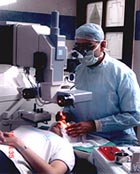|
|
 Utilizing
the accuracy and precision of the excimer laser, LASIK
changes the shape of the cornea to improve the way light
is focused or "refracted" by the eye. Utilizing
the accuracy and precision of the excimer laser, LASIK
changes the shape of the cornea to improve the way light
is focused or "refracted" by the eye.
First, a thin layer of the cornea, or corneal flap, is
lifted up as an instrument called a microkeratome glides
across the cornea. Then, in seconds, an ultraviolet light
from the excimer laser reshapes the internal cornea with
extreme accuracy.
 By
adjusting the pattern of the laser beam through its computer,
it is possible to treat high levels of nearsightedness,
farsightedness and astigmatism. After the tissue has been
reshaped, the flap is replaced in its original position. By
adjusting the pattern of the laser beam through its computer,
it is possible to treat high levels of nearsightedness,
farsightedness and astigmatism. After the tissue has been
reshaped, the flap is replaced in its original position.
Because of the cornea's extraordinary natural bonding
qualities, healing is rapid and does not require stitches.
LASIK surgery is performed as an outpatient procedure
in the comfort and convenience of the excimer laser surgical
suite.
 The
entire vision correction procedure takes less than 30
minutes and both eyes are done the same day. The procedure
is performed using topical anesthesia (eye drops). Some
patients report a slight, post-operative discomfort that
can usually be alleviated with medications. The
entire vision correction procedure takes less than 30
minutes and both eyes are done the same day. The procedure
is performed using topical anesthesia (eye drops). Some
patients report a slight, post-operative discomfort that
can usually be alleviated with medications.
Patients see a dramatic improvement in their vision within
the first day. Most patients return to their normal activities
within a day or two.
The LASIK
procedure takes a few minutes to complete, and the procedure
is relatively painless. Patients are always amazed at the
ease of this procedure because of speed and comfort. Only
topical anesthetic drops are used to numb the eye for the
procedure. An eyelid holder is inserted to prevent blinking
while the drops eliminate the reflex to blink. With LASIK,
the surface epithelial layer is left intact, allowing for
not only faster visual recovery but improved comfort and safety.
 Step
1 : A
suction ring is placed on the eye to secure the eye
and maintain pressure within the eye while the corneal
flap is created.
Step
1 : A
suction ring is placed on the eye to secure the eye
and maintain pressure within the eye while the corneal
flap is created.
Step
2 : A microkeratome, an automated microsurgical
instrument similar in design to a carpenter's plane,
is used to create a thin corneal flap which remains
hinged beneath the upper eyelid. The corneal flap is
160 to 180 microns thick, about 30% the corneal thickness
which is typically about 550 microns. Patients do not
feel or see the cutting of the corneal flap, which takes
only a few seconds. Corneal "flap making" has been researched
and developed for 40 years, providing us with a long
history of safety and stability.
Step
3 : The corneal flap is then laid back and the inner stromal layers
of the cornea lasered with the patient's prescription.
Step
4 : The corneal flap is then repositioned and the
flap and interface rinsed.
Once the
procedure is completed, the surgeon will wait 2 to 3 minutes
to ensure the corneal flap has fully re-adhered. At this point,
patients can blink normally and the corneal flap remains secured
in position by the natural adherence within the cornea. While
it is possible to dislodge the corneal flap during the first
day or two by physically rubbing the eye, this event is actually
quite rare. After the first week, LASIK patients can resume
their full exercise activities. Since the protective layer
remains intact with LASIK, no bandage or contact lens is required.
LASIK
patients are placed on an antibiotic and anti - inflammatory
drop for about 1 week. LASIK patients are instructed to wear
a protective glasses during waking hours for 7 days to prevent
accidental trauma to the cornea flap during the early healing
period. Patients are able to travel by air immediately and
exercise after 1 week.
|
|

